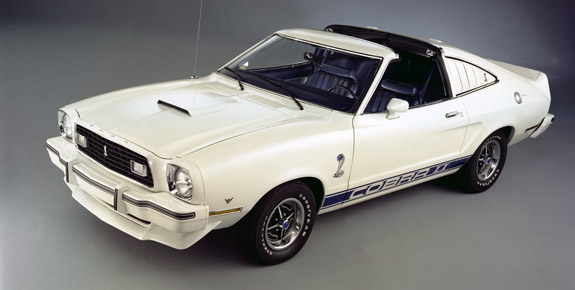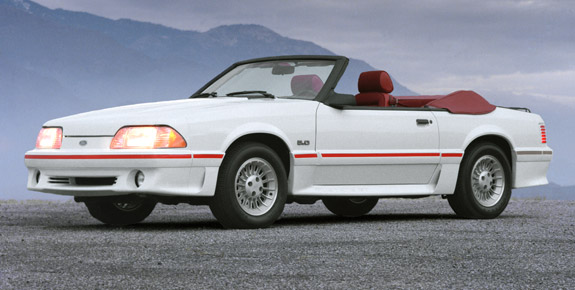Mustang Story
Vehicles- Design in Motion
- An icon of muscle car power and innovative styling, the Mustang continues to thrill a broad customer base with its legendary appeal.
Ford Mustang News
-
Mustang Alley Features Nearly 50 Years of Ford Mustang Heritage On Display at the Annual Woodward Dream Cruise
August 14, 2013 -
Sold for $500,000: 2014 Ford Shelby GT500 Convertible Delivers for Brain Injury Association of America at Hot August Nights
August 14, 2013 -
Mustang Milestones
August 13, 2013 -
Ford Accelerates Product Led Transformation Plan in Australia
August 12, 2013 -
Ford Launching ‘Mustang Countdown’ Video Series Celebrating Nearly 50 Years of Mustang Culture and Legend
August 02, 2013 -
The Ford Donated U.S. Air Force Thunderbirds Edition Ford Mustang Raises $398,000 to Support Youth and Aviation
August 02, 2013
The history of the mustang
Take the Tour
A Drive Through History
1964
Mustang Roars onto the Scene
Success from the starting lineup.
The original Ford Mustang debuted on April 17, 1964, at the attractive price of $2,368. Dealers were inundated with requests for the sleekly-styled new vehicle. In Garland, Texas, 15 customers thronged to bid on the same Mustang. The winning bidder resorted to sleeping overnight in his new car so that it wouldn’t be sold out from under him before his check could clear.
Ford initially forecasted annual sales of about 100,000 units. On the first day alone, dealers took 22,000 Mustang orders. Shortly after its introduction, the fledgling vehicle’s success was official when it was featured on the racetrack as the pace car for the 1964 Indianapolis 500. During the Mustang’s first 12 months on the market, sales built to an astounding 417,000. Within two years, sales had catapulted to one million.
“When the Mustang was unveiled, the reaction was so positive that there was no doubt it was going to be a success,” recalls Joe Oros, chief designer of Ford’s original pony car – dubbed the 1964½, because it was launched at an unusual halfway point during the year.
Click the thumbnail below for Part 2 of the story.Mustang Roars onto the Scene
Success from the starting lineup.The rest of the story...

Don Frey, Product Planning Manager for the original Ford Mustang, says he knew the car was going to be a hit months earlier when the design team gave Ford employees a sneak peek at one of the prototypes. “We built the first prototype in an experimental garage, and employees flooded the place to see it. Their reaction was spectacular, and it was very revealing to us. We knew the car was going to be roaring success from the start.”
Frey says he believes the car had such dramatic appeal because the styling was very unusual for its day. “The design was very European, particularly the front end. There was no other car like it in North America at that time.” Another facet of the original Mustang’s appeal was that it was made to suit the tastes of a wide range of customers; available models included economical “base,” high-performance and luxury variants, which featured the most extensive roster of options Detroit had offered to date. Three distinct body styles were manufactured, as well - convertible, hardtop and fastback.
“Mustang was designed to be designed by you,” an original print ad declared. And it was true. Everyone who owned a Mustang believed no one else had a vehicle like his, and yet the Mustang had enduring universal appeal. Despite its status as an icon of automotive lore, the Mustang remains as wildly popular as ever with enthusiasts everywhere.
1965
1975
1976
1984
1987
The Public Weighs In - Mustang Is Here To Stay
When Mustang's legacy seemed in jeopardy, a public outcry ensured that the journey continued.
While the Mustang legacy continued to burnish bright from the early to mid-80s, Ford’s product development team was looking for alternatives to the popular Fox-body. By 1987, it was again time for Mustang to evolve with the changing market. Designers gave the Fox-body – the platform introduced in 1979 – a facelift with new “aero-look” design and a 5.0-liter V-8 with 225 horsepower.
“There were people who thought Mustang was headed for the scrap heap,” said Ressler. “Sales were sluggish, and they thought that front-wheel drive modern-looking cars were the wave of the future.” After Ford signed an agreement with Mazda to build the Mazda 626 and MX-6 at a new plant just outside of Detroit, the idea was to use the front-wheel drive Mazda platform as the underpinnings for the “new Mustang.”
“When news came out that the all-American Mustang was going to be based on a Japanese car and built by a Japanese company, plus move to front-wheel drive and again go back to losing its V-8 engine, the nameplate’s legion of fans could hardly believe it,” said John Clor, author of The Mustang Dynasty. “By the time a cover story in AutoWeek magazine hit the newsstands on April 13, 1987 – questioning ‘The Next Mustang?’ – the Mustang-badged Mazda was already the target of a letter-writing campaign launched by the editors of Mustang magazines across the country.”
The public spoke out with a vengeance, and Ford listened. The front-wheel drive Mazda became the 1989 Ford Probe, and the iconic vision of the Ford Mustang lived on.
“It was the only time I can remember in my career when the will of the public affected a major decision in advance of the decision being made,” Ressler said. “They brought about something I thought at the beginning was worth trying but wouldn’t work. But I was enthusiastic. I thought it was crazy to get rid of the only performance rear-wheel drive car we had.”
1993
Mustang Gets Racier
The low-volume 1993 Cobra R - originally developed as a race car - sold out prior to production.27 March 2012

In 1993, Ford’s new Special Vehicle Team (SVT) introduced the limited-production SVT Mustang Cobra, which sported subtle yet distinctive styling cues and performance upgrades. The low-volume 1993 Cobra R, developed to be driven as a race car, sold out prior to production.
In the early 90s, Ressler and a group of performance enthusiasts within the company came up with the idea to build an increased-performance Mustang out of Ford Motorsports performance parts (now known as Ford Racing Performance Parts). Based on the lessons learned from the SVO Mustang program, this group's goal was to attract driving enthusiasts to the Ford brand.
“It was a confederation of people, all of whom had their own home organizations in different areas within the company, such as Marketing, Engineering and Product Planning,” Ressler explained. “When we worked together, we described our activities as occurring with the Special Vehicle Team or SVT.”
Ressler confided that many of the projects the team spearheaded at Ford – such as the Mustang Cobra – were not formally approved by upper management. “We just found the money and thought that as long as we were doing things that were good for the company, we were safe not to ask for permission,” he said. “We were prepared to ask for forgiveness, but we never had to.”



















































Ford Motor Company Lincoln Motor Company
Ford Motor Company Lincoln Motor Company
Ford Motor Company
Ford Motor Company Lincoln Motor Company